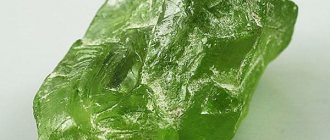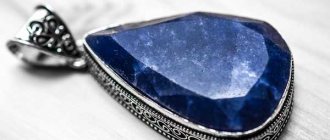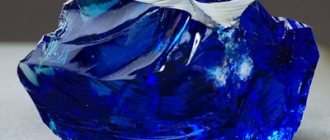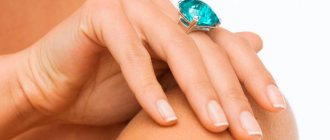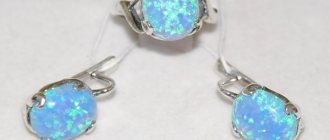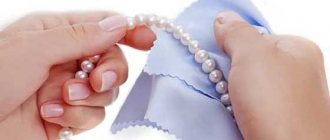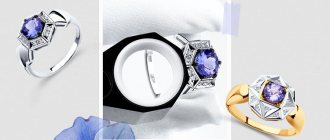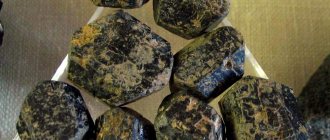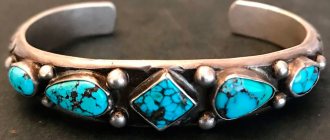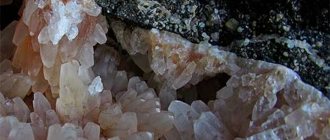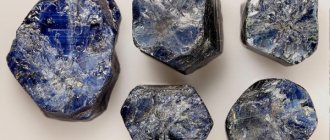Any precious and semi-precious stone is subject to high requirements, compliance with which determines the final cost of the stone and the jewelry adorned with it. Sapphires, one of the most expensive and beautiful minerals, are no exception. There are 4 generally accepted parameters by which the quality of sapphire can be determined.
Color
One of the main indicators of the quality of sapphires is the depth and richness of their shade. For blue stones, the reference shade is the shade of Kashmir corundum, pure cornflower blue. For fancy corundums, that is, those colored in colors other than red, there is no generally accepted standard.
To determine the color indicators of a mineral, professionals use special tables; the color is determined visually, without the use of instruments. This characteristic of sapphire has three components: tone, saturation and lightness. Interestingly, the last parameter is valued differently in different countries. Thus, dark corundums are more popular in Russia, while light corundums are more popular in Europe.
There are five categories of lightness and three of saturation; shades are usually divided according to the spectrum, but to simplify the classification in commerce, three names are used: bright (1), medium (2) and light (3) blue.
Where are sapphires mined? History of the stone
Fortunately or unfortunately, there is no clear legend about the origin of sapphire. The mineral was known to man in deep Antiquity; even cuneiform references to sharp dark blue stones, which were used as a working tool by the masters of Ancient Babylon, have been preserved. Another reference is found in the “Revelation” of John the Theologian, where one of the twelve steps of the walls of the Heavenly City is lined with sapphires.
The origin of the word itself is still controversial. The Greeks, descendants of the Persians, as well as some Semitic peoples are fighting for the right to be called “discoverers”. It is ironic that in all cases the translation is the same - “blue stone”, and what language it came from is an impossible task. In Rus', until the middle of the 18th century, they were universally called yakhonts, and rubies too, without division - today this archaism is practically unheard of.
Sapphires are mined mainly in the Asian region, which is why the gem has received the unofficial status of an “oriental” stone. The most valuable samples suitable for a jewelry workshop are found on the island of Sri Lanka, near the Pakistani-Indian region of Kashmir, in Myanmar and Thailand. Several deposits are located in the American state of North Carolina, and there is information about explored veins on the Australian continent.
In Russia, sapphires are almost never mined, at least not on a scale that would allow launching autonomous production. There are small veins in the Urals and in the extremely cold Khibiny belt. This situation directly affects the market value of stones - high-quality refined minerals sometimes cost several times more than diamonds. The most popular among buyers are raw materials brought from Indochina.
Purity
The purity of sapphire is an important characteristic that affects the value and quality indicators of corundum. How to determine purity? First, it is determined by eye, and then a tenfold magnifying glass is used in order to study in more detail all the features of a particular specimen. The purity of a stone also means its transparency: these concepts are equivalent to each other. Below is a classification table that includes a description of the properties of stones, dividing them into four categories according to the level of purity and transparency.
| Category | Properties |
| 1 | Stones belonging to the first category have an almost perfect transparency. There are no serious defects inside, but there may be small inclusions that will only be noticeable upon detailed examination with a magnifying glass. Usually this doesn't matter much. The first category includes specimens of high value and purest color. |
| 2 | A sapphire stone of the second category can also be called transparent, but its color is more saturated, and the internal structure is characterized by the presence of defects and inclusions that are not visible under a magnifying glass. This means that the quality of sapphire of the 2nd category is not bad, but it may cost a little less than the stones of the first category. |
| 3 | Sapphire 3/3, or third category, is a completely opaque corundum, which has defects and inclusions inside, visible to the naked eye. You can also purchase this type of stone; as a rule, it’s not only a matter of price, but also of taste preferences, which can be different. |
| 4 | The characteristics of sapphire of the fourth category are low transparency, immediately noticeable defects, and uncertainty of color. Such stones can be quite cloudy, and their cost is much lower than that of representatives of the first two categories. |
When determining, it is important to consider that there is no other “scheme” that could be applied specifically to sapphire. Fraudsters or unprofessional sellers can sometimes use the IF category for advertising purposes and apply it to corundum, designating individual specimens as “a stone of perfect purity and transparency.” However, keep in mind that in reality, category IF, approved by one of the leading gemological institutes in the United States, has nothing to do with sapphires: “perfectly pure” corundum simply does not occur in the natural environment. Read about methods of refining sapphires here →
What does the concept of “sapphire quality” mean? This is a combination of color and purity indicators. Thus, a 3/3 sapphire (where the first number is color, the second is clarity) is of lower quality than a 1/1 stone.
How to choose a sapphire stone of decent quality? If you know about the four categories that determine its purity, you will have a much easier time completing this task. I would like to note right away that in some cases you may not need additional magnification. However, in order to choose the right sapphire, the characteristics of which will be the most worthy, you can carry a magnifying glass with you to exhibitions and sales of precious stones and use its help at any time.
Read also about diamond purity →
Steps
Buy quality stones
- Decide what shade of blue you want.
Sapphires are blue, their shades range from the lightest (Princess of Sweden) to dark blue and black. The most valued shade is “royal blue”, located in the middle of the shade scale. Accordingly, it also applies to the most expensive stones. Stones in the Camelot and Commodore shades, respectively, are slightly lighter and slightly darker, are very similar in color, but are slightly cheaper.
Consider the shade.
Sapphires are pure blue, but can have a greenish or purple tint. Pure blue stones are valued the most, followed by stones with a slight purple tint. A strong purple or green tint is generally considered undesirable.
Assess the transparency of the stone.
When buying a sapphire, people do not always pay attention to the transparency of the stone, but the more transparent the stone, the brighter it will look. At the same time, transparent stones are more expensive. Transparent and translucent gems allow most of the light rays to pass through them. Translucent sapphires allow some light to pass through but darken it, making them a good compromise between transparency and cost. Dull and opaque stones allow little or no light to pass through.
Look at sapphires in fancy colors.
Although the primary color of sapphires is blue, these gems are also found in a variety of other colors. Pinkish-orange sapphires (subparadscha) are very rare and highly prized. Pink sapphires are also popular. Colorless, yellow and green sapphires are much less valuable.
Be aware that the origin of a sapphire affects its price.
Where sapphire is mined can significantly influence the cost of sapphire. Sapphires mined in Kashmir, Mogok, Myanmar (Burma) and Sri Lanka are usually more valuable than others. This is because the quality of stones from mines in these areas tends to be higher than those from other areas. This is not always true and paying for the origin of a stone is like paying for a brand. You can save money by purchasing quality sapphires from lesser-known mines.
Pay attention to the cut.
The cut is not the same as the shape of the stone. Cutting is a method of processing the surface of a stone to show off the color and clarity of the stone at its best. Sapphires with deeper cut facets have better color, while shallow cut facets often appear too large for their weight and have a lighter tint. There are excellent, very good, good, fair and poor cuts.
- Look for ratings from official organizations such as the Gemological Institute of America. Jewelers can assign their own ratings to stones, but, as a rule, they are higher than the official ones.
- Blue sapphires have more inclusions.
A sapphire's purity grade refers to the number of inclusions and defects within the stone. The fewer defects, the more expensive the stone will be. The official classification of stone purity (from the same Gemological Institute of America, for example) is available online.
- Stones of the VVS (with small inclusions), VS (with small inclusions) and SI1 (with small inclusions) groups are transparent sapphires with single defects, so small that they can only be distinguished under significant magnification.
- I1, I2 and I3 are sapphires with a slight loss of transparency; defects and inclusions in them are clearly visible even to the naked eye.
SI2 group stones are transparent sapphires, minor defects in which are clearly visible under magnification, but do not particularly affect the light transmission of the stone.
Almost all sapphires that go on sale undergo a process of “refinement”. Most often, it consists of strongly heating the crystal to 2000 degrees for several hours, so that it acquires a more uniform and rich color. Sapphires that have not been subjected to such treatment do not have inclusions and have an excellent color - they are rare and expensive; but since heat treatment is so widely used, treated sapphires are still very valuable.
Buy wisely
- Set a budget.
Be clear about how much you can afford to spend on a stone before you fall in love with a stone outside your budget. The price of a sapphire can range from $50 per carat to over $10,000 per carat, and the most expensive sapphire was sold for $135,000 per carat. The cost of a sapphire is determined mainly by its quality, and a large stone of low quality can cost much less than a small one of high quality. Cut is the most important indicator of quality, since it is the one that most influences the brilliance of the stone. Next comes the purity of the stone (the number of inclusions), then the color.
Choose a setting metal that complements the stone.
A cool-toned metal setting (silver or white gold) works best with blue sapphires. Subparadscha sapphires look gorgeous with yellow gold, while pink sapphires go well with both silver and gold.
Beware of possible fakes.
Small sellers may try to sell cheaper gems under the guise of sapphires to inexperienced buyers. Tanzanite, blue spinel and blue tourmaline are some of the minerals that dishonest sellers may pass off as real sapphires.
Deal only with reputable sellers.
Chain jewelry stores are a good place to start your search because they have more control than small private stores. If you buy in small jewelry stores or from private sellers, always ask for an official certificate for the stones offered, which will indicate information about the deposit of the mineral, its weight, etc. A law-abiding jeweler will be able to provide you with such a certificate.
Cut
The cut of a sapphire and the method of processing the gemstone depend on its internal structure. As you know, there are different types of corundum, to which one or another cutting method can be applied.
In some cases, professional cutters use a method called cabochon:
- if the mineral belongs to the so-called star-shaped;
- if the sapphire has a large number of foreign inclusions or other defects that interfere with the classical cut.
In the first case, we are talking about the effect of asterism, when, after polishing, a star appears on the surface of a stone turned at a certain angle. In the case of sapphires, it will be 6- or 12-rayed. This effect is exhibited by varieties of minerals that contain needle-shaped rutile inclusions located at an angle to the surface. Asterism significantly increases the value of corundum.
Sapphires that do not have noticeable inclusions and are not capable of asterism are cut in the usual, faceted way: the stone can be given a round or oval shape, or made pear-shaped. Any colorless and seemingly unremarkable stone will become much more attractive after conventional processing.
How to distinguish natural sapphire from artificial?
In the jewelry market, it is not customary to pass off artificial stones as natural ones. Therefore, when choosing jewelry, you need to be careful and know what is inserted into it - a natural gem or an artificially grown mineral?
The most basic difference lies in the origin of the mineral. Natural, as is obvious from the name itself, is found and extracted from nature (it was formed in difficult conditions over many years). Synthetic or hydrothermal is obtained in the laboratory in a short period of time (grown in 2-3 weeks). To create a hydrothermal mineral, all the same chemical components are used as in natural minerals, and similar conditions are used - high temperature and pressure. A mineral grown in laboratory conditions is of higher quality, it does not have impurities that are possible in natural conditions, and also, due to constant monitoring of the process, the crystal is cleaner, without cracks and air bubbles. Synthetic has a more durable color, unlike natural. It is not affected by UV rays, so it can be worn around the clock. The difference in price is probably the most important thing. With equal characteristics it will be about 10 times. That is, if a natural sapphire costs $400, its hydrothermal “brother” of the same size will cost only $40.
Carat
The weight of precious stones, including sapphires, is measured in carats. 1 carat is equal to 0.2 grams. But how can you understand how much a mineral in a piece of jewelry weighs if you can’t check it separately on a jewelry scale? You can measure its size.
Carat table for sapphires of the three most popular cuts:
| Round | Oval | Pear | |||
| mm | carats | mm | carats | mm | carats |
| 1 | 0,01 | 5×3 | 0,35 | 5×3 | 0,30 |
| 2 | 0,05 | 6×4 | 0,60 | 6×4 | 0,50 |
| 3 | 0,15 | 7×5 | 1,00 | 7×5 | 0,85 |
| 4 | 0,34 | 8×6 | 1,55 | 8×5 | 1,05 |
| 5 | 0,60 | 9×7 | 2,20 | 9×6 | 1,85 |
| 6 | 1,05 | 10×8 | 3,15 | 10×7 | 2,50 |
| 7 | 1,70 | 11×9 | 3,80 | ||
| 8 | 2,30 | 12×10 | 6,00 | ||
| 10 | 4,75 | ||||
If you are not purchasing jewelry from a trusted seller, and there is a suspicion that a sapphire that is too small in size weighs 2, 4, 6 carats, etc., as indicated on the tag, use a ruler and table.
Popular jewelry with sapphires
The online catalog of the Karatov online store offers a large selection of products:
- Earrings;
- Rings;
- Bracelets;
- Piercings;
- Necklace;
- Brooches;
- Crosses;
- Pendants and pendants.
How to care for sapphire jewelry?
After your long-awaited purchase, do not forget the rules for caring for sapphire jewelry:
- The use of chemical reagents is strictly prohibited - only warm soapy water, or in case of severe contamination - baking soda paste.
- You can clean the joints with the edging with a soft toothbrush, but be careful that the bristles do not get stuck in the metal fastener.
- You can polish sapphire with a soft cloth soaked in ammonia solution - 4-6 drops per glass of filtered water at room temperature.
- Ultrasonic cleaning is undesirable - the products used in the procedure can lead to irreversible clouding of the crystal.
Store a sapphire item, especially a sharp cut one, preferably separately from other jewelry in a velvet bag. Take off your jewelry every time you are going to take a bath, go to the sauna or pool - sudden temperature changes are detrimental to it.
Origin
The above parameters are part of the four C rule, as it is called in Europe. But there is another, no less important indicator that determines the quality of corundum. This is its place of origin.
Despite the fact that sapphire deposits have been discovered on all continents, the purest and most attractive for the final owner are those from Kashmir, Ceylon, and Tanzania. The value of Kashmir is especially high, since this deposit is no longer being developed.
Burmese and Thai are considered to be of lower quality; stones from Australia have the lowest price on the market. In Russia, corundums are found in the Ural Mountains (often have a grayish tint) and on the Kola Peninsula (usually cornflower blue).
CHARACTERISTICS OF SAPPHIRE
Sapphire is one of the varieties of the common mineral on earth - corundum. Most often, corundum is an accumulation of granular formations of gray-brown color. But sometimes transparent crystals – precious sapphires – form in its depths.
Descriptions of stones are found among many peoples, from whose chronicles the ancient names of sapphire are known - yaksinthos among the Greeks, yakut and yakut among the Persians and Arabs, yakhont and baus among the Slavs.
The modern word “sapphire” comes from the ancient Greek σάπφειρος (sappheiros) and literally means “blue stone”. Until the 19th century, all blue minerals bore the name. However, today only crystals with certain physical characteristics are called sapphires.
Physico-chemical properties of sapphire
In terms of chemical composition, sapphires are crystalline α-aluminum oxide (Al2O3), the crystals of which are formed in igneous rocks at great depths.
The strength of sapphire is high and is rated 9 out of 10 on the Mohs scale: only diamond is stronger, so processing the stone is not an easy task.
Melting point - 2040°C, density - 3.93 g/cm3. Such characteristics allow the stones to be used in high-energy work, and also not to worry about their safety in jewelry.
What does sapphire look like?
Raw and uncut natural sapphire, when extracted from the depths of the earth, looks like an opaque or slightly transparent mineral. After clearing the accompanying rocks, the master can obtain an ornamental material - cloudy stones with a large number of foreign inclusions - and transparent crystals of all colors of the rainbow.
Where are sapphires mined?
- Extensive deposits of sapphires are located in the USA, Kashmir, Vietnam, Burma, Thailand, and China.
- Colored sapphires are mined mainly in Australia, Kenya, India, Sri Lanka and Madagascar.
- There are also known deposits on the Kola Peninsula (Russia), where sapphires with a rare gradient from green to deep cornflower blue are mined.
Famous sapphires and prices
Whether a real sapphire is an expensive stone depends on many parameters. Slightly less valuable than ruby, it is more often found in nature. History knows unsurpassed specimens of the gem.
- The St. Edward's Sapphire is a 167-carat rose-cut dark blue stone set in the upper cross of the Crown of the British Empire. According to legend, the talisman was worn by St. Edward the Confessor himself, so the stone is a symbol of God’s blessing on the British monarchy.
- The Imperial State Sapphire of the Russian Empire, a still unnamed diamond-cut stone weighing 200 carats, was commissioned by Catherine II in Ceylon (India) and placed in the State for prestige.
- Princess Diana's famous ring contains a relatively small sapphire - only 18 carats. However, the jewelry is known throughout the world thanks to its first owner, Diana SPENCER. After her death, the ring was kept in Kensington Palace for a long time, but now belongs to Kate MIDDLETON.
- "Star of India" - one of the largest star sapphires in the world, weighing 563 carats, is kept in the American Museum of Natural History. The stone amazes with the skill of its processing: the six-rayed star is located exactly in the center of the dome, regardless of the angle of inclination.
- Logan Sapphire - a crystal weighing 423 carats, ranked among the largest faceted sapphires, once belonged to one of the Indian maharajas. The last owner, Rebecca Guggenheim LOGAN, donated the jewelry to the Smithsonian National Museum in Washington.
We recommend: KARL U KLARA, or what kind of stone is coral
Stones have rather cultural value, as a symbol and property of royal families, museums or countries. Everyone has a material equivalent. Princess Diana's ring costs $44,000.
The price of a gem consists of many items:
- purity of sapphire;
- size;
- color, tone and saturation;
- cutting and subsequent processing;
- story.
Gems larger than 1 carat cost:
- fancy - from 60 to 200 $ per carat,
- blue - from 300 to 500 $.
| fantasy shade | 4 - 13 thousand rubles |
| blue tint | 20 thousand - 34 thousand rubles |
Only a jeweler or gemologist can tell you exactly how much a sapphire costs.
Product marking
It is difficult for a non-specialist to determine at first and even at second glance what kind of stone he is holding in his hands. Therefore, each stone or jewelry decorated with corundums has a certificate indicating all the characteristics of the sapphire. For jewelry, this is usually a tag attached to the item. To read it correctly, you need to know what the letter abbreviations and numbers indicated on the tag mean.
Usually the inscription looks something like this: 1C Kr. 2×3 0.22 1/2. The numbers are taken as an example so that you can clearly see the meaning of each indicator.
- 1C – number of stones and their name. In this case, one sapphire.
- Kr. - a cutting method, the letters will change depending on the shape that the stone was given.
- 2x3 – size.
- 0.22 – carat weight.
- 1/2 – indicators of the color and purity of the stone.
Please note that for stones processed abroad, a letter designation of purity will be indicated: VVS, VS, SI, I. They mean the same thing as the domestic digital system, in the same order.
In any case, to insure yourself against counterfeiting, it is better to purchase sapphires from trusted stores. Modern technologies make it possible to produce elements so similar to natural ones that only a professional can distinguish them.
Healing and magical properties of sapphires
Many stories are known about the magical effect on humans; we have collected the most interesting ones that still accompany the mineral:
- It is useful to wear it for people of creative professions - the hidden energy helps to reveal inspiration even in moments of despair.
- In a number of Asian cultures, blue corundum is strictly a feminine stone. It is customary to tie it around the neck of newborn girls so that they grow up beautiful. Adult women hide the crystal in their belts in order to hasten the successful conception of a child.
- Esotericists are sure that the darker the sapphire, the more powerful its effect on the human subconscious. It drives away bad thoughts and helps identify ill-wishers.
Among the healing properties of the stone, there is a lot of talk about the calming effect. It is useful for hypertensive patients to admire blue hues to normalize blood pressure, and those who believe in a rejuvenating effect should purchase a sapphire pendant for their neck.
Story
Ruby is a red variety of the mineral called corundum. Natural corundum also includes sapphire, the closest relative of ruby.
Ruby has been known to mankind for a very long time, probably since the Bronze Age. This red stone is mentioned in the oldest book of human civilization, the ancient Indian sacred epic “Mahabharata”, in the fourth book of “Virata Parva” (section “The Tale of Cattle Theft”, chapter 54):
“Oh, greatest of the Brahmanas Vayaghra! I command that you be given precious stones, and cows, and gold, and rubies, and pearls.”
The modern name of the gem - ruby (lat. rubinus) - comes from the Latin roots ruber or rubeus, which literally means “red”.
The guess that ruby and sapphire are close relatives from the common corundum family belongs to the great French mineralogist Rene Gaüy. He first mentioned this in 1805.
The best, most expensive rubies in the world are mined in Burma. Deposits of these minerals are also found in Thailand, Vietnam, Cambodia, Kenya, Tanzania and Kashmir (Pakistan). These precious gems are also mined in Tajikistan and the Pamirs (Snezhnoye deposit).
